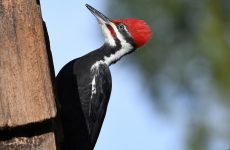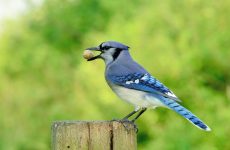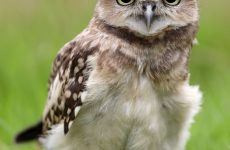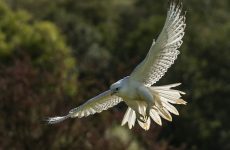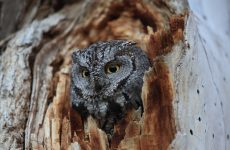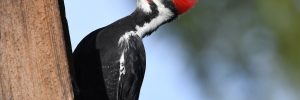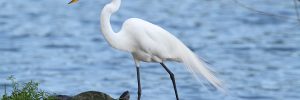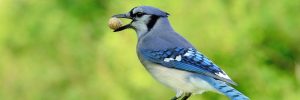Whether you are backyard birdwatching or out on a hike these are the most common birds that you will see in winter in Alberta.
How many have you spotted?
25 Common Winter Birds Alberta
1. Black-billed Magpie
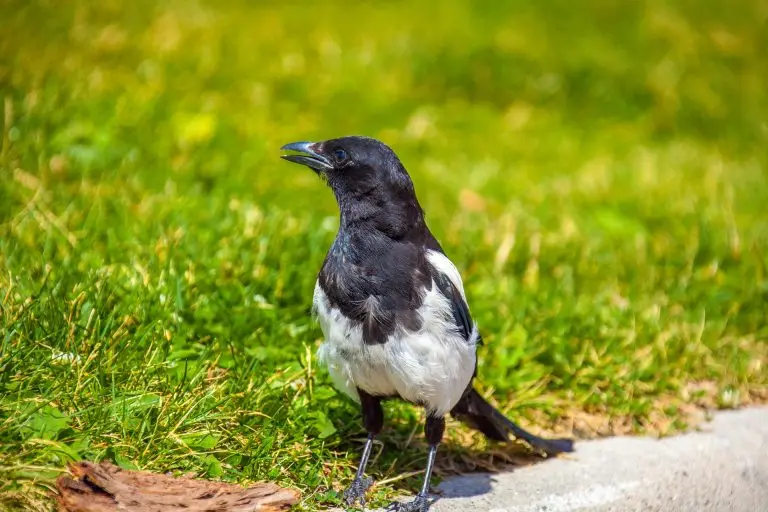
Black-billed Magpies, usually just called Magpies, are black and white birds that are noisy. They have long tails and blue-green iridescent flashes in the wing and tail. Males are up to 25% heavier than females.
- Pica hudsonia
- Length: 17.7-23.6 in (45-60 cm)
- Weight: 5.1-7.4 oz (145-210 g)
- Wingspan: 22.1-24.0 in (56-61 cm)
Black-billed Magpies live in northwestern US states and western Canada, and the coast of Alaska. They do not migrate.
You can find them walking on the ground in meadow and grasslands or other open areas feeding on fruit and grain, beetles, and grasshoppers. They have also been known to kill small mammals such as squirrels and voles and raid bird nests for eggs or nestlings and even carrion.
Black-billed Magpie sounds: A series of harsh calls and also a scream.
You can attract Black-billed Magpies to your backyard with platform and suet feeders with black oil sunflower seeds, peanuts, fruit, suet, millet, and milo.
Fun Fact: A gathering of magpies calling around one of their dead is called a funeral.
2. Black-capped Chickadee
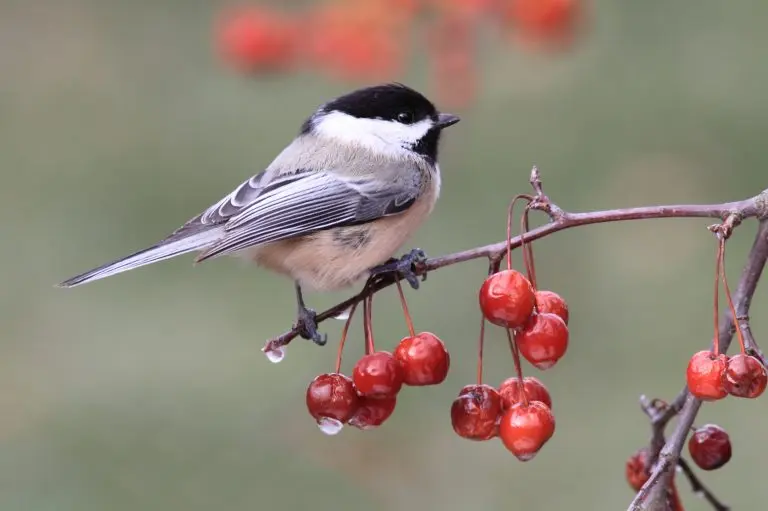
The Black-capped Chickadee is a cute bird with a big round head and tiny body. These birds will happily feed at backyard feeders and investigate everything, including you!
They have black caps and beaks, white cheeks, and are gray on the back, wings, and tail.
- Poecile atricapillus
- Length: 4.7-5.9 in (12-15 cm)
- Weight: 0.3-0.5 oz (9-14 g)
- Wingspan: 6.3-8.3 in (16-21 cm)
Black-capped Chickadees do not migrate and can be spotted in the northern half of the US and Canada.
You can find them in forests, open woods, and parks. Black-capped Chickadees eat seeds, berries and insects, spiders, and suet.
Black-capped Chickadee Call/Song:
Attract Black-capped Chickadees to your backyard with suet, sunflower seeds, and peanuts or peanut butter. They will even feed from your hand and are often one of the first birds to discover new feeders. They will also use nest boxes, especially if you fill them with wood shavings.
3. Common Raven
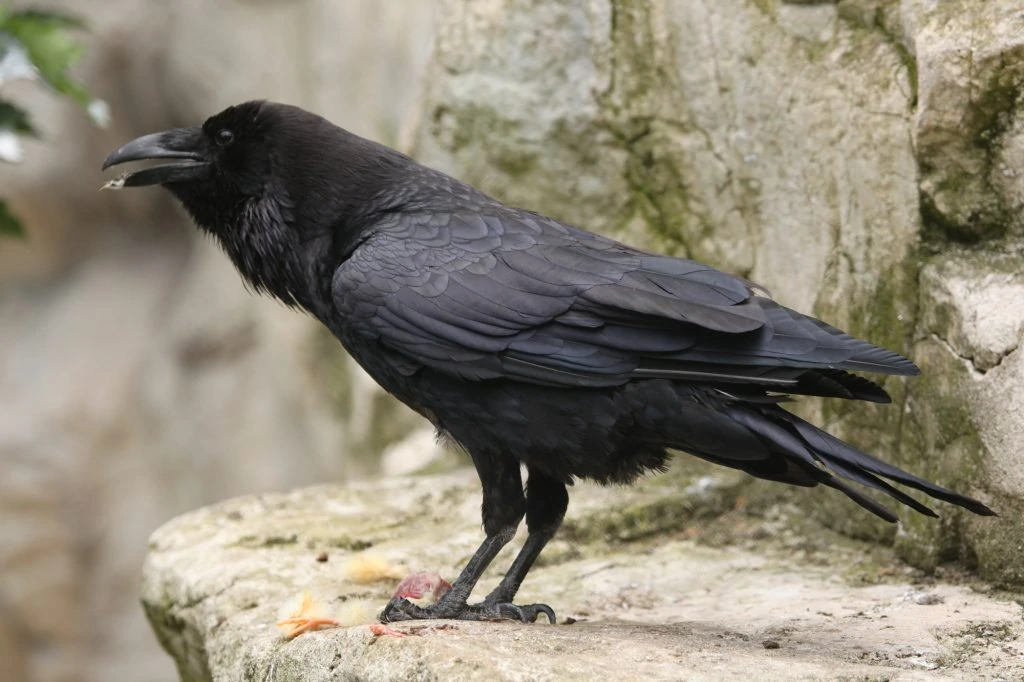
Common Ravens are thought to be one of the smartest and definitely one of the largest species in the songbird family. They have shaggy throat feathers, large black beaks, and wedge-shaped tails.
- Corvus corax
- Length: 22.1-27.2 in (56-69 cm)
- Weight: 24.3-57.3 oz (689-1625 g)
- Wingspan: 45.7-46.5 in (116-118 cm)
Common Ravens are resident in Canada, western US states, northeastern US states, Mexico, and northern Central America. They are not found in the Great Plains or eastern US states.
You can find Common Ravens in most places, and they especially follow humans. Forests, beaches, fields, grasslands are all places to find them and rural human areas. They are not common in towns and cities as American Crows take over.
Not known as picky eaters, Common Ravens will eat most things, including any small animals, eggs and nestlings, plus insects and fish. Human rubbish and pet food
Common Raven sounds: Mostly croaks and harsh calls
Fun Fact: Common Ravens in Canada weigh up to 60% more than those in California.
4. Downy Woodpecker
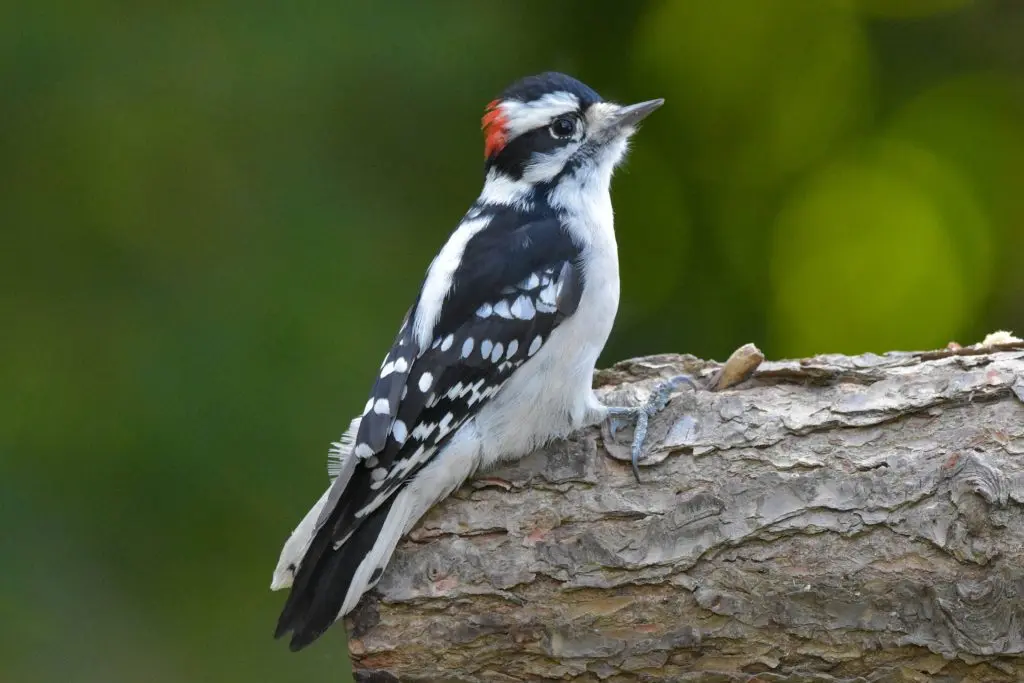
Downy Woodpeckers are small birds that are common at backyard feeders. They are often mixed in with other birds, such as chickadees and nuthatches.
They have black and white coloring with a red patch at the back of their heads. They look similar to the Hairy Woodpecker but smaller.
- Dryobates pubescens
- Length: 5.5-6.7 in (14-17 cm)
- Weight: 0.7-1.0 oz (21-28 g)
- Wingspan: 9.8-11.8 in (25-30 cm)
Downy Woodpeckers do not migrate and can be spotted in most states and provinces, except the north of Canada.
You can find Downy woodpeckers in woodlots, along streams, city parks, and backyards, and they eat mainly insects and beetle larvae but also berries, acorns, and grains.
Downy Woodpecker Call:
Attract Downy Woodpeckers to your backyard with their favorite treat of suet, but they will also eat black oil sunflower seeds, millet, and peanuts on platform feeders.
5. House Sparrow
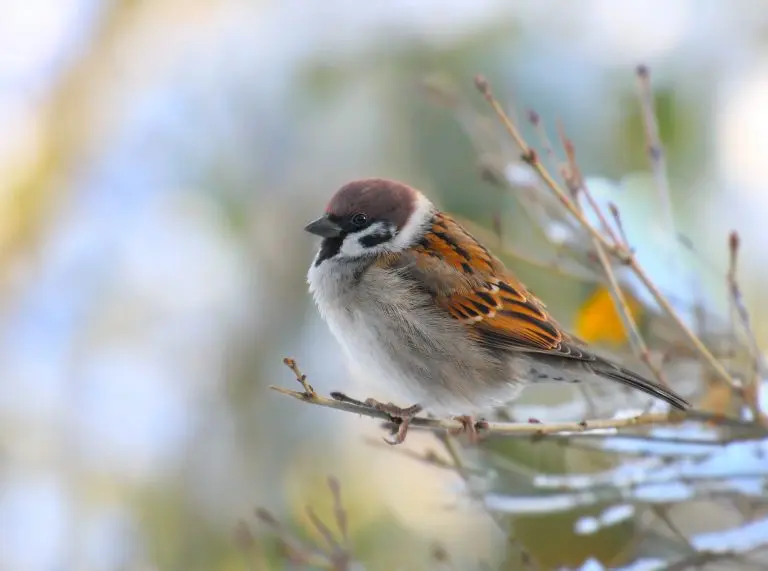
The House Sparrow is another introduced species that has done very well and is now one of the most common birds. They have gray and brown heads and white cheeks. Their backs are black and brown, and their bellies are gray.
- Passer domesticus
- Length: 5.9-6.7 in (15-17 cm)
- Weight: 0.9-1.1 oz (27-30 g)
- Wingspan: 7.5-9.8 in (19-25 cm)
House Sparrows live in the US and Southern Canada all year.
You can find them near houses and buildings, and they can be pretty tame, and they may even eat out of your hand.
House Sparrows eat mostly grain and seed as well as discarded food. They can be considered a pest because they are non-native, but they are found in backyards even if you do not feed them.
House Sparrow Song:
Attract House Sparrows to your backyard feeders with most kinds of birdseed, including millet, corn, and sunflower seeds.
6. Blue Jay
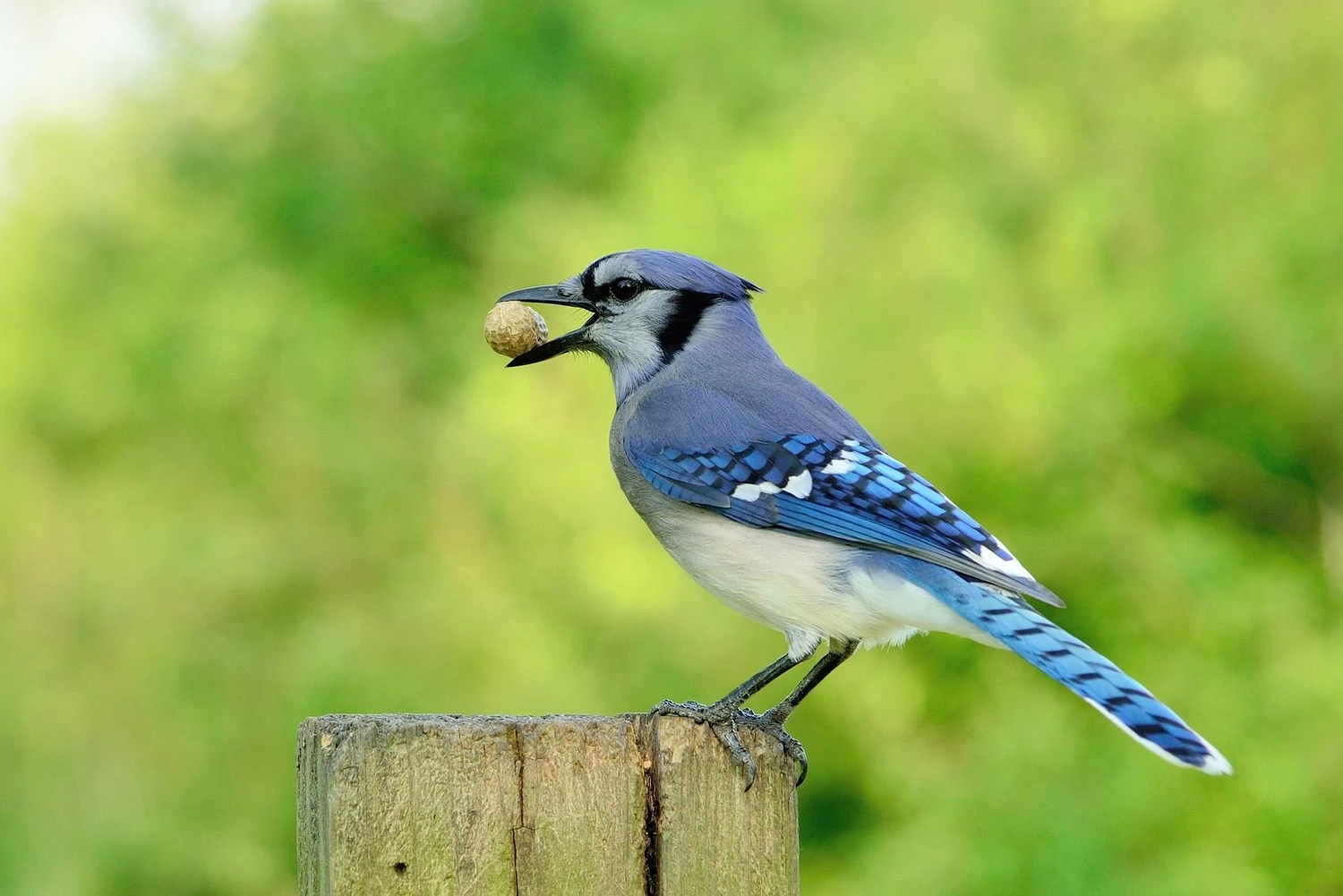
Blue Jays are common large songbirds with a blue upright crest, blue and black backs, and white undersides.
- Cyanocitta cristata
- Length: 9.8-11.8 in (25-30 cm)
- Weight: 2.5-3.5 oz (70-100 g)
- Wingspan: 13.4-16.9 in (34-43 cm)
Blue Jays live in eastern US states and Southern Canada all year. Some birds will migrate west for winter but not very frequently.
They are noisy birds that travel in family groups eating acorns when available. They can be found in forests, mainly near oak, as they eat acorns. They can also be found in backyards near feeders. As well as acorns, they eat insects, nuts and seeds, and grain. They may also take eggs from nests or take nestlings.
Blue Jay Call:
Blue Jays are large birds and prefer to fly in, grab a peanut or sunflower seed and take it away to feed. They prefer platform or tray feeders to make it easy to make a quick exit.
Attract Blue Jays to your backyard with peanuts, sunflower seeds, and suet. They prefer these on open tray feeders or hopper feeders on a post. They will also enjoy a birdbath.
7. Red-breasted Nuthatch
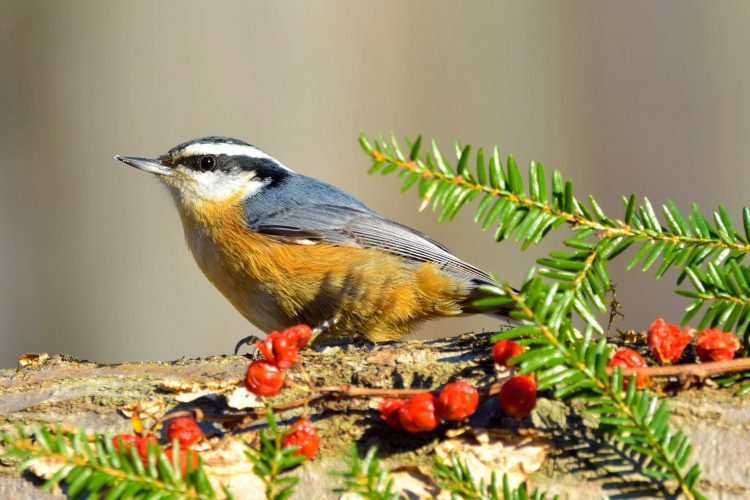
Red-breasted Nuthatches are blue-gray birds with black and white stripes on their heads and a rusty underside.
- Sitta canadensis
- Length: 4.3 in (11 cm)
- Weight: 0.3-0.5 oz (8-13 g)
- Wingspan: 7.1-7.9 in (18-20 cm)
Red-breasted Nuthatches remain all year in northeastern and western states, Alaska and Canada but may move south in winter if cone crops are poor.
You can find Red-breasted Nuthatches in coniferous woods foraging for cones, and they also visit backyard feeders.
Red-breasted Nuthatch Call:
Attract Red-breasted Nuthatches to your backyard with black oil sunflower seeds, suet feeders, peanuts, and mealworms.
8. White-breasted Nuthatch
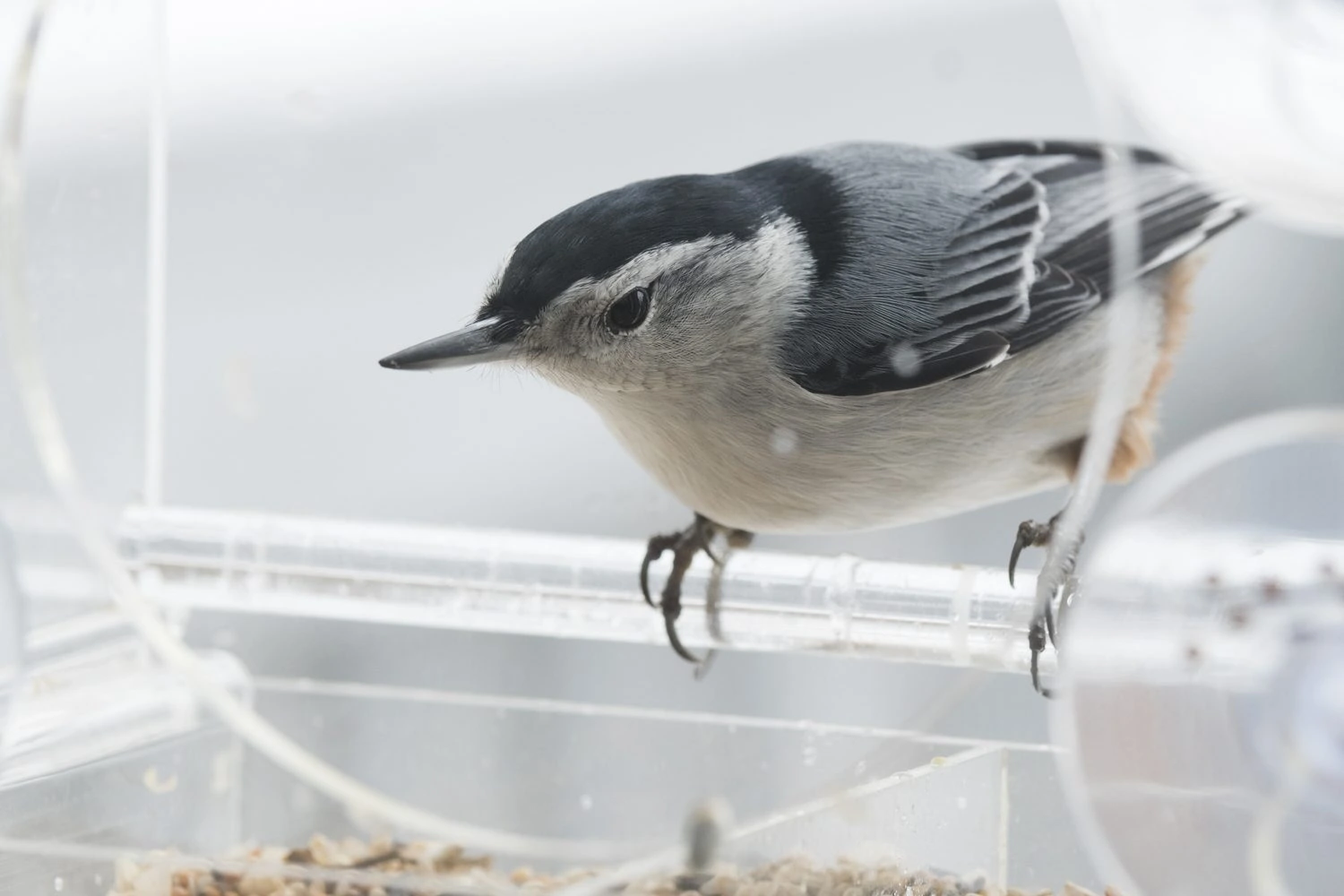
White-breasted Nuthatches are active little birds that are gray-blue on the back and white on the face and belly, with a black cap. They will often have a chestnut color on the lower belly and under the tail.
- Sitta carolinensis
- Length: 5.1-5.5 in (13-14 cm)
- Weight: 0.6-1.1 oz (18-30 g)
- Wingspan: 7.9-10.6 in (20-27 cm)
White-breasted Nuthatches live all year in the US and southern Canada.
You can find White-breasted Nuthatches in deciduous forests, woodland edges, parks, and yards with trees or at feeders. They mainly eat insects, including beetles and their larvae, caterpillars, ants, and also spiders.
White-breasted Nuthatches also eat seeds and nuts, including acorns, hawthorns, sunflower seeds, and sometimes corn crops. They jam large nuts and acorns into tree bark and then whack them with their bills to open or ‘hatch’ them to get the seed out.
White-breasted Nutcracker Call:
Attract White-breasted Nuthatches to your backyard with sunflower seeds and peanuts on tube feeders or suet feeders.
9. Common Redpoll
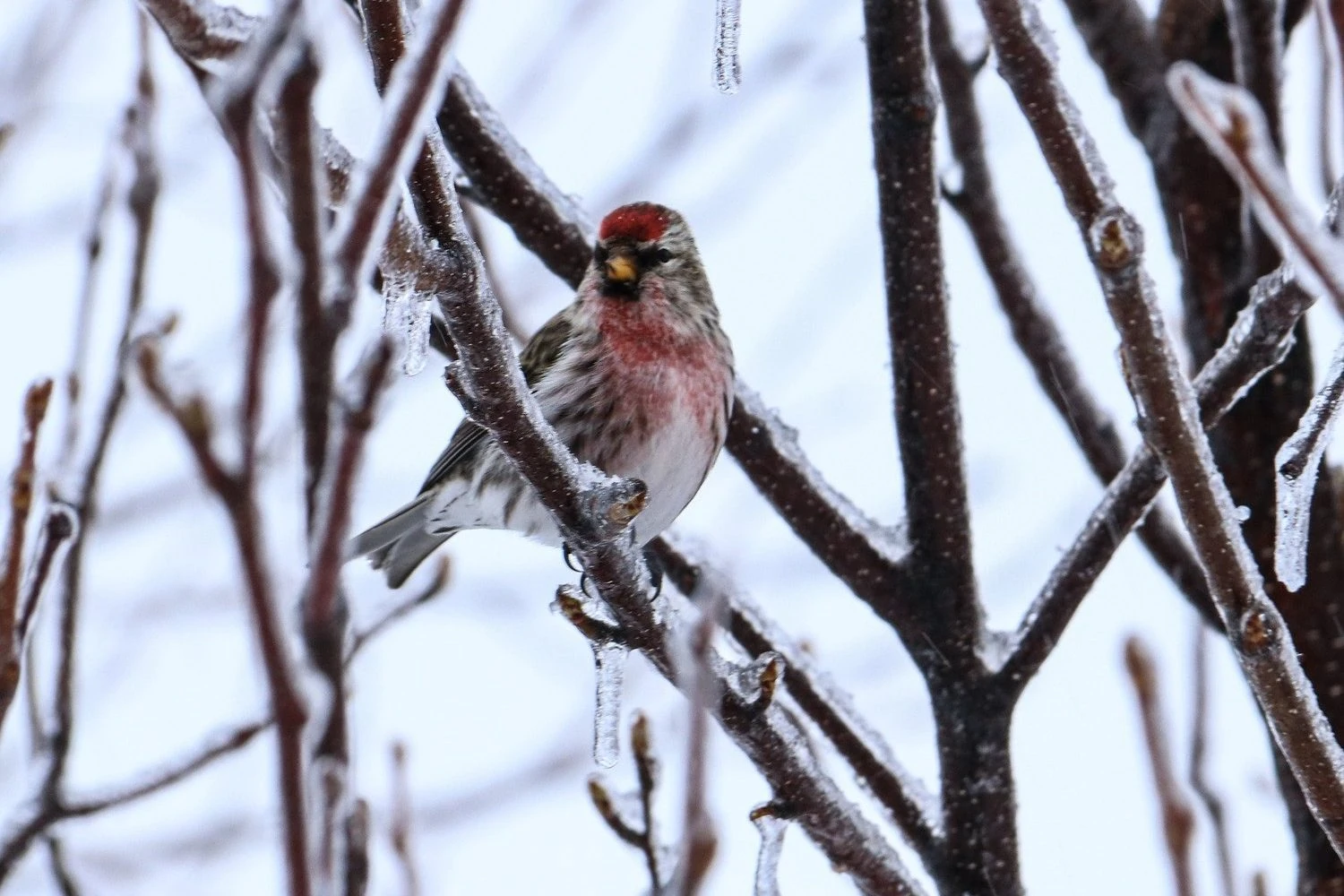
Common Redpolls are small and have red foreheads, and are brown and white streaked over the rest of their bodies. Males also have pink breasts, but females do not. They have small bills for finch and a short notched tail.
- Acanthis flammea
- Length: 4.7-5.5 in (12-14 cm)
- Weight: 0.4-0.7 oz (11-20 g)
- Wingspan: 7.5-8.7 in (19-22 cm)
Common Redpolls breed in artic in Canada and spend the winter in the rest of Canada and northern US states and less frequently in central US states.
In winter, they will sometimes tunnel into the snow to stay warm during the night. They can eat up to 42% of their body mass every day and can store up to 2 grams of seeds in a stretchy park of their esophagus.
You can find Common Redpolls in weedy fields or feeding on catkins in trees, but they will also come to feeders for small seeds such as nyjer seeds or thistle.
Common Redpoll Song:
Attract Common Redpolls to your backyard by feeding them nyjer seeds and shelled sunflower seeds.
Fun Fact: Common Redpolls can survive temperatures of -65 Fahrenheit without freezing to death. They add around 30% more feathers to stay warm.
10. Northern Flicker
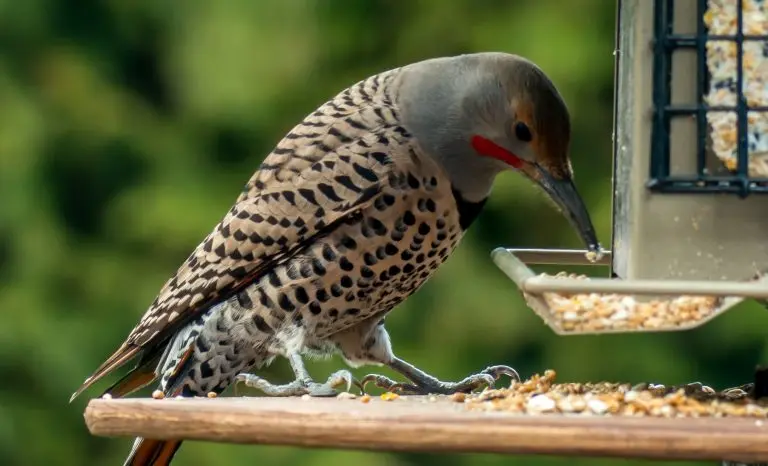
Northern Flickers are large brown woodpeckers with black spots and a white patch on their rump in flight, plus a red nape of the neck in the males.
Northern Flickers have red or yellow flashes in the wings and tail depending on where they originate. Red-shafted birds live in the west, and yellow-shafted birds live in the east.
- Colaptes auratus
- Length: 11.0-12.2 in (28-31 cm)
- Weight: 3.9-5.6 oz (110-160 g)
- Wingspan: 16.5-20.1 in (42-51 cm)
Northern Flickers can be spotted across the US all year and in Canada during summer. Those that breed in Canada migrate south for the winter.
Northern Flickers mainly eat ants, beetles, fruits, and seeds, and they can often be seen on the ground digging with their curved bill.
Northern flicker Call:
Attract Northern Flickers to your backyard with suet.
11. House Finch
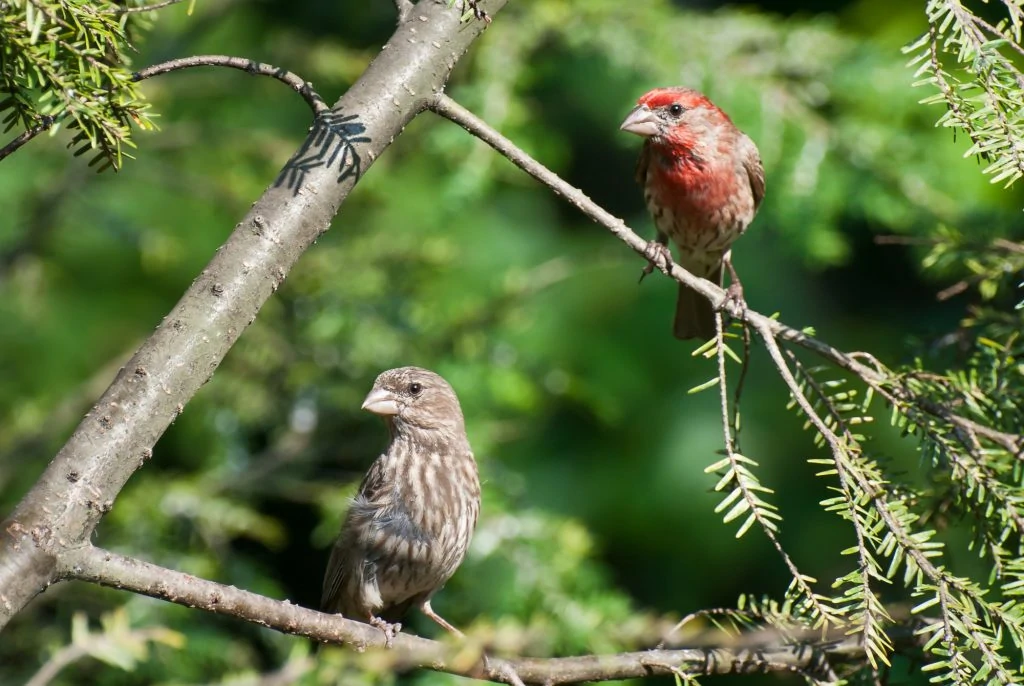
House Finches males have a red head and breast, and the rest of their bodies are mainly brown-streaked. Females are brown-streaked all over.
- Haemorhous mexicanus
- Length: 5.1-5.5 in (13-14 cm)
- Weight: 0.6-0.9 oz (16-27 g)
- Wingspan: 7.9-9.8 in (20-25 cm)
Originally only in western US states, House Finches were introduced to eastern US states and have done very well, even pushing out the Purple Finch.
They can be found in parks, farms, forest edges, and backyard feeders in noisy groups that are hard to miss.
House Finch Song:
House Finch Call:
Attract House Finches to backyard feeders with black oil sunflower seeds or nyjer seeds in tube feeders or platform feeders.
12. Canada Goose
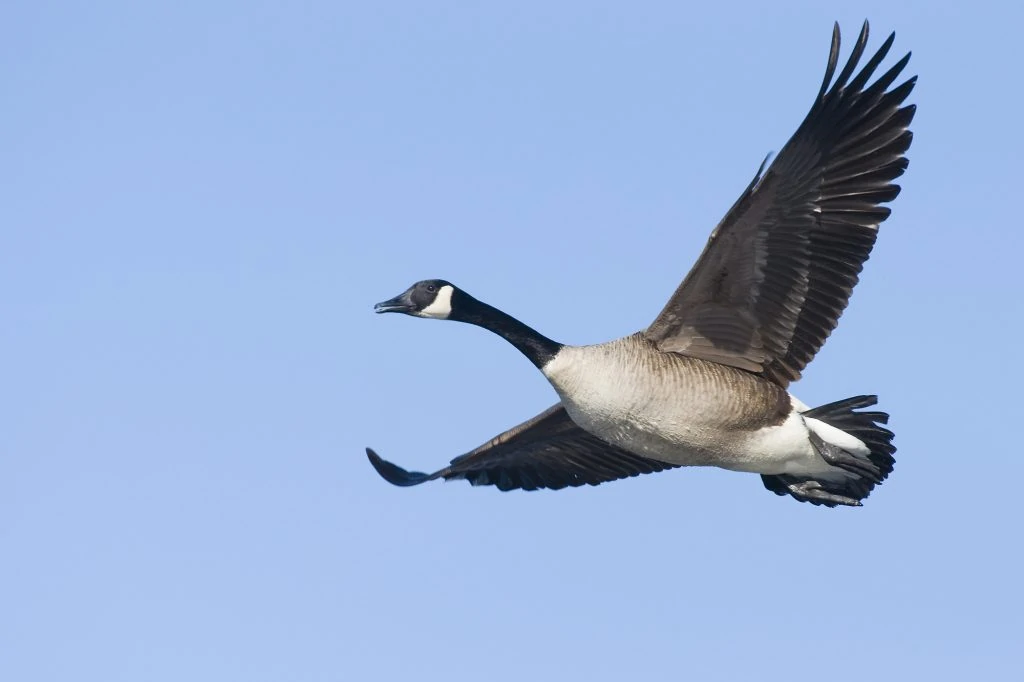
The Canada Goose, also called the Canadian goose, is a large, long-necked goose recognized for its black head and easily identifiable white chin strap.
Canada Geese look very similar to Cackling Geese, and they have the same black head and white chin strap, but their long, graceful neck and large size separate them.
Their bodies are brown with a tan or pale chest and white rump. The color of the bodies among the subspecies may be shades of gray or brown. Their legs and webbed feet are black.
- Branta canadensis
- Length: 25 – 45 in (64 – 114 cm)
- Weight: 230.09 oz (6521 g)
- Wingspan: 70 – 75 in (178 – 190 cm)
As their name would suggest, Canada Geese breed in Canada and migrate for the winter to southern US states, but those in northern US states remain all year and do not migrate. They are also found in western Europe.
You can find Canada Geese practically anywhere. They are often seen near lakes and rivers, basically, anywhere there’s a body of water and an abundant food source. They are also used to humans, so they live comfortably in urban habitats like city parks, reservoirs, golf courses, public parks, and beaches.
In some places, their population has risen considerably and they’re considered pests.
Canada Geese mainly eat grasses when they’re on land and small aquatic insects and fish when they’re on the water. They also eat wheat, rice, and corn when they’re on agricultural fields. They’re accustomed to receiving food from humans or digging through trash cans.
Canada Goose Call:
Fun Fact: During the breeding season, adults lose their flight feathers because it coincides with their molting season. They only regain their feathers after twenty to forty days, just in time for them to fly with their young.
13. Hairy Woodpecker
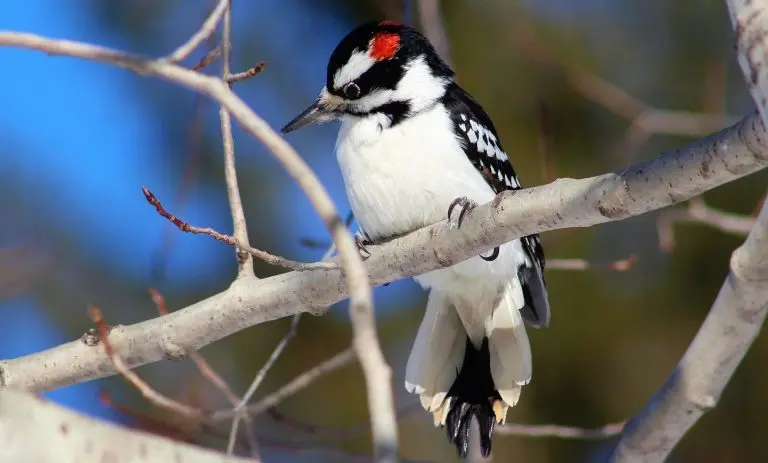
Hairy Woodpeckers are medium-sized woodpeckers with a black and white pattern and a large white patch on their backs. The males have a flash of red towards the back of their heads.
They are visually similar to Downy Woodpeckers but larger and with longer bills. As they are often found in the same areas, it is hard to tell them apart if they are not near each other.
- Dryobates villosus
- Length: 7.1-10.2 in (18-26 cm)
- Weight: 1.4-3.4 oz (40-95 g)
- Wingspan: 13.0-16.1 in (33-41 cm)
Hairy Woodpeckers do not migrate and live in all US states and Canada, except the far north of Canada.
You can find Hairy Woodpeckers in woodlands on trunks or main branches of large trees, but they are also found in a wide variety of habitats, including woodlots, parks, and cemeteries. Hairy Woodpeckers’ diet is mostly insects.
Hairy Woodpecker Call/drumming:
Attract Hairy Woodpeckers to your backyard with suet feeders.
14. Mallard
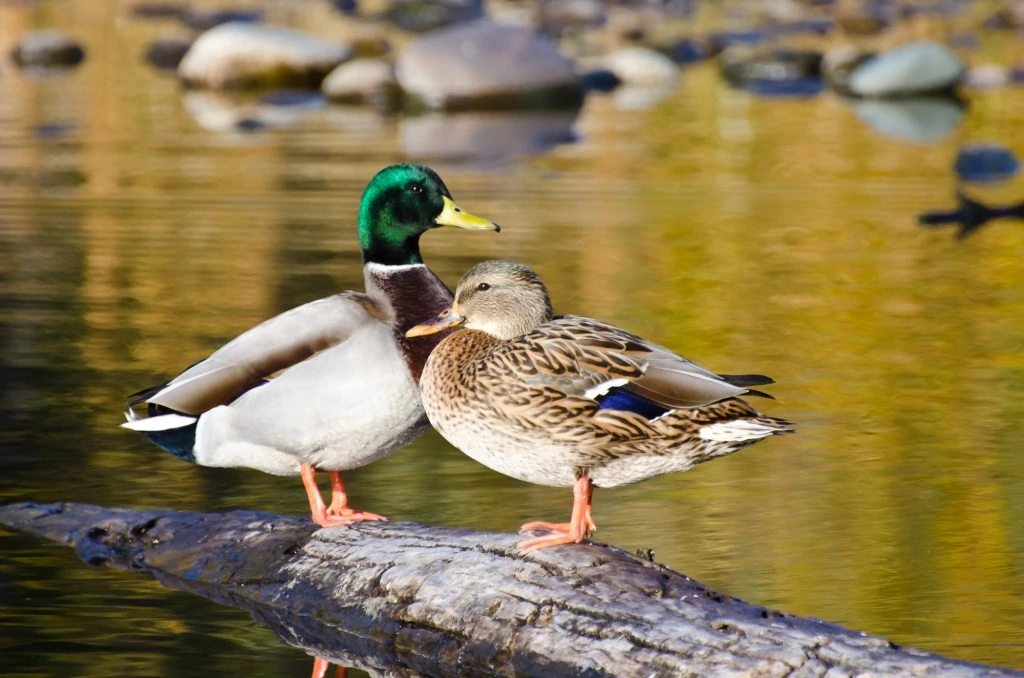
Mallards are large ducks, and the males have striking green heads. They also have bright yellow bills and gray bodies with brown breasts and black towards the tail. They have a curl of tail feathers and a blue patch on the wings bordered with white which is called a speculum.
Females and juveniles are mottled brown with orange bills but still have the blue speculum.
- Anas platyrhynchos
- Length: 19.7 – 25.6 in (50 – 65 cm)
- Weight: 35.3 – 45.9 oz (1000 – 1300 g)
- Wingspan: 32.3 – 37.4 in (82 – 95 cm)
Mallards remain all year in most of the lower 48 and the western coast of Canada and Alaska. Those that breed in Canada and Alaska head south to the southern United States and northern Mexico.
Mallards are one of the most commonly spotted and recognizable ducks that will happily be fed on ponds and rivers. They are dabbling ducks that feed on water plants and do not dive. They are very long-lived, and they have been recorded at 27 years old.
Mallard Calls:
Male Mallards don’t quack, only females do. Instead, the male makes a rasping sound.
Male Mallard Call
Female Mallard Call
Fun Fact: Most domesticated ducks are descended from Mallards, and they have been hunted and bred for food.
15. Rock Pigeon
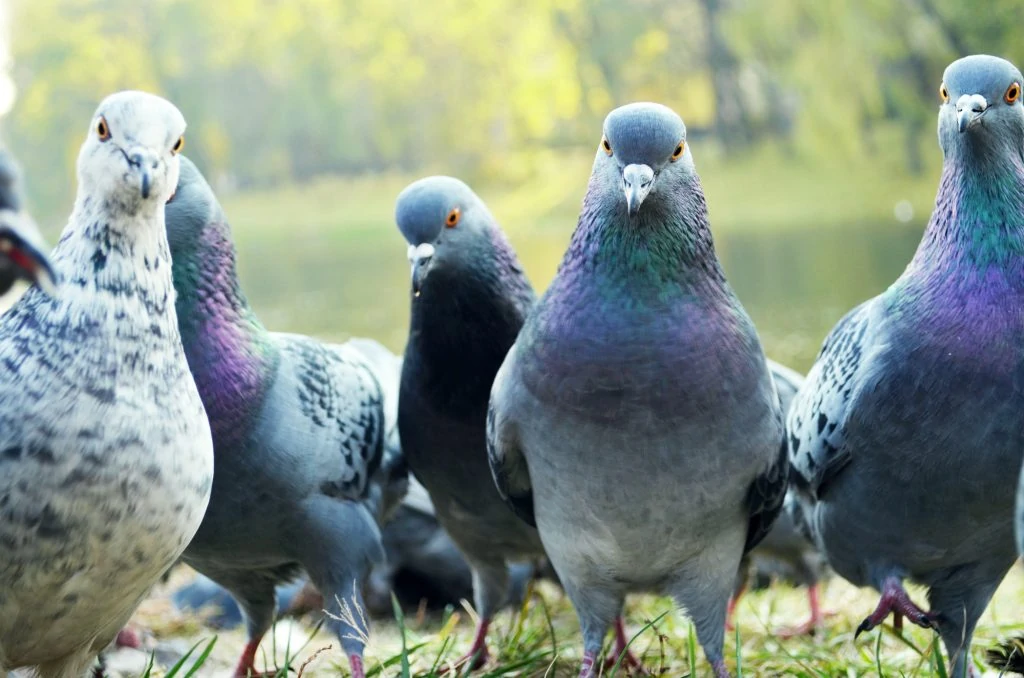
Rock Pigeons are well recognized around towns and parks and are usually blueish gray with two black bands on the wing and black on the tail tip. They have iridescent throat feathers and orange eyes.
However, they can also be white, spotted, or red.
- Columba livia
- Length: 11.8-14.2 in (30-36 cm)
- Weight: 9.3-13.4 oz (265-380 g)
- Wingspan: 19.7-26.4 in (50-67 cm)
Rock Pigeons do not migrate and can be found in all US states, southern Canada, and the Pacific Coast to Alaska.
You can find Rock Pigeons in cities, parks, and backyards, especially if there is birdseed on the ground. Some cities have ordinances against feeding pigeons as they are considered pests.
Rock Pigeon Call:
Fun Fact: Rock Pigeons have an amazing ability to find their way home using the earth’s magnetic field.
16. Bohemian Waxwing

Bohemian Waxwings are robin-sized birds with distinct red, waxy tips on their wing feathers which give them their name. They get it from the carotenoid pigments from the fruits that they eat.
Adult Bohemian Waxwings are buff-gray or grayish-brown overall with shaggy crests and a black mask and peachy faces. Their wings are black, white, yellow and red patterned.
Juveniles are grayer than adults. They also have no peachy blush around their faces and they lack the red-tipped secondary wing feathers.
- Bombycilla garrulus
- Length: 6.3 – 7.5 in (16 – 19 cm)
- Weight: 1.6 – 2.24 oz ()45 – 69 g)
- Wingspan: 13.0 in (33 cm)
Bohemian Waxwings are found around the world in the northern hemisphere. In North America they breed in western Canada and Alaska and migrate to southern Canada and northern US states for winter.
You can find Bohemian Waxwings in mature conifer and broadleaf woodland with open and wet areas near lakes, ponds, and streams for foraging for insects.
During the non-breeding season, they look for fruit in parks and gardens, hedges, and woodland edges.
Bohemian waxwings eat a huge number of berries and Rowan berries are their favorite but they also eat strawberries, raspberries, and cranberries. They will also eat insects during the breeding season.
Bohemian Waxwing Calls:
Nests of Bohemian Waxwings are built on a horizontal branch of an evergreen, aspen, or alder tree. Both adults collect twigs, grasses, and moss, to build the nest, but it’s the female who actually constructs a cup nest. In it, she’ll lay two to six eggs which she’ll incubate for about a couple of weeks.
Attract Bohemian Waxwings to your backyard with trees that bear berries in late fall and winter.
Fun Fact: Bohemian Waxwings have an eerie sense of where they can find fruit. They forage in large flocks and eat their share of the fruits and move on to the next location.
17. Common Goldeneye
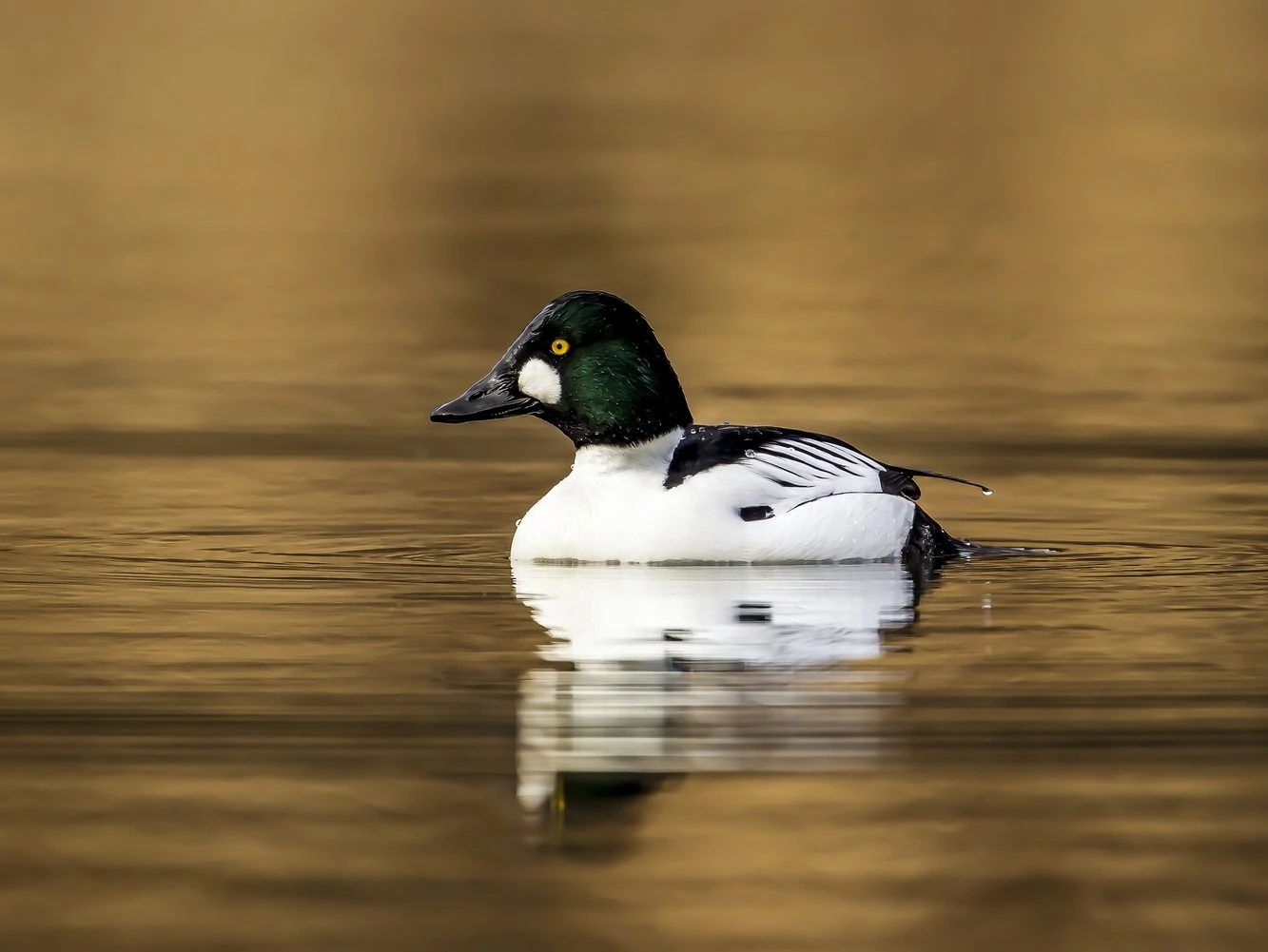
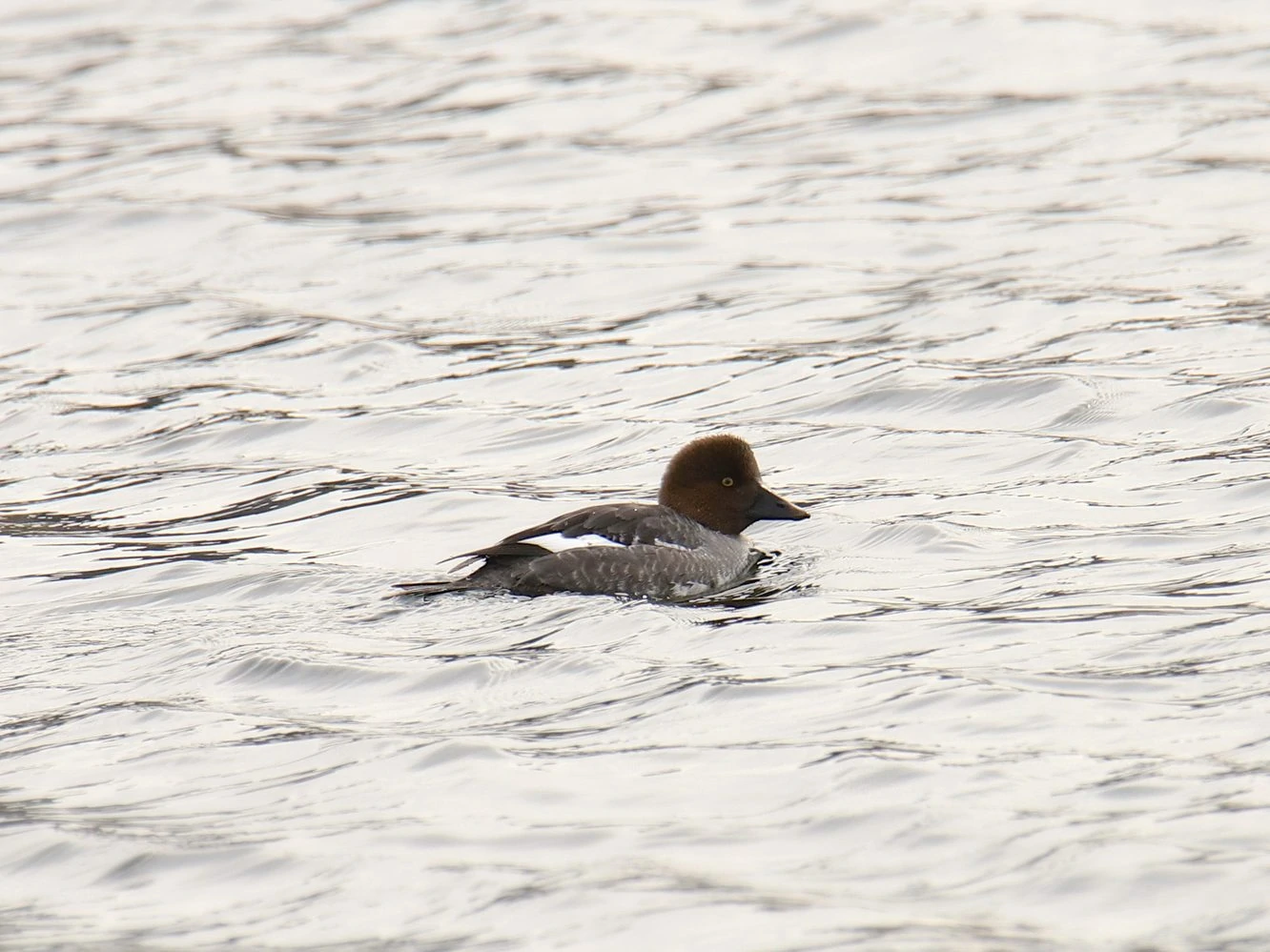
Common Goldeneye males have green heads that are iridescent and can look almost black. They have a white spot under their yellow eyes. They have white bodies and sides and black backs.
Female Common Goldeneyes are grayish-brown with brown heads. Both males and females have black bills, but females have a yellow tip.
- Bucephala clangula
- Length: 15.8 – 20.1 in (40 – 51 cm)
- Weight: 21.2 – 45.9 oz (600 – 1300 g)
- Wingspan: 30.3 – 32.7 in (77 – 83 cm)
Common Goldeneyes breed in Canada and Alaska in summer and migrate late to the lower 48 for winter.
You can find Common Goldeneyes in boreal forest lakes during the breeding season and in coastal areas in winter. Common Goldeneyes are diving ducks that feed on crabs, shrimp, crayfish, fish, fish eggs, and insects.
Common Goldeneye Calls: They are quiet ducks, but male Common Goldeneyes make soft calls, and females make harsh alarm calls.
Common Goldeneye Male
Common Goldeneye Alarm call
Fun Fact: Common Goldeneyes can fly at speeds of over 40 miles per hour.
18. Pine Grosbeak
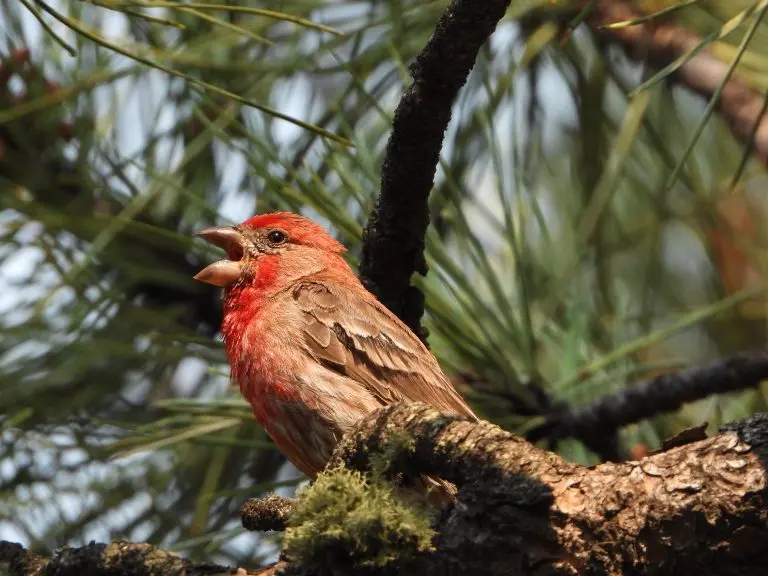
Pine Grosbeaks males are red birds with gray on the wings and tail and two white wingbars. Females are gray with dull orange heads and rumps. They are large for finches and relatively slow.
- Pinicola enucleator
- Length: 7.9-9.8 in (20-25 cm)
- Weight: 2.01 oz (57 g)
- Wingspan: 13.0 in (33 cm)
Pine Grosbeaks are mostly found in Canada, but some can be spotted along the US border, the mountainous west, and the Sierra Nevada in California.
You can find Pine Grosbeaks in forests of pine, spruce, and fir, feeding on seeds, fruit, and buds from these trees. They will also eat some insects in the summer.
Pine Grosbeak Call:
Attract Pine Grosbeaks to your backyards with black oil sunflower seed feeders or suet feeders.
Fun Fact: Pine Grosbeaks are aptly named. Their scientific name, “Pinicola,” is Latin for “pine dweller.”
19. Bald Eagle
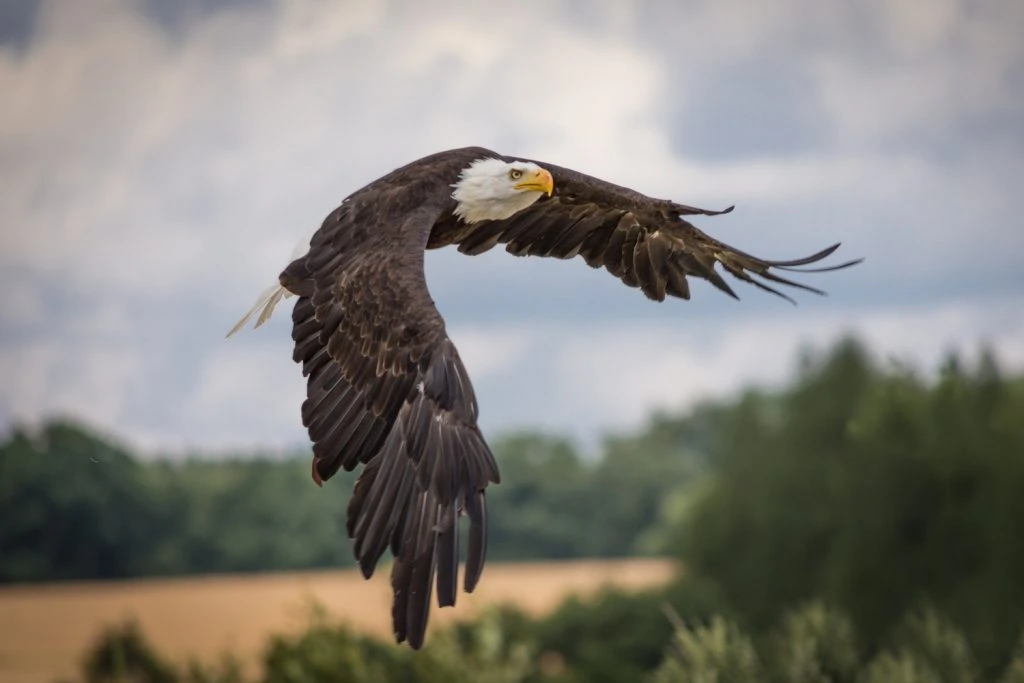
The Bald Eagle is a widely-recognized bird of prey. It has a white head, yellow eyes, and a large, hooked yellow bill. Its body is chocolate brown, and its legs are yellow, with huge talons.
Females look similar to males, except they’re about 25% larger. Juveniles have dark brown heads and bodies with variable white mottling or streaking until they reach their fifth year.
- Haliaeetus leucocephalus
- Length: 34 – 43 in (86 – 109 cm)
- Weight: 168 oz (4761 g)
- Wingspan: 72 – 96 in (183 – 244 cm)
Bald Eagles breed predominantly in Canada and then migrate to the United States for winter. However, some remain resident all year, especially in coastal regions.
You can find the Bald Eagle, during its breeding season, in wetland environments. Open and large bodies of water with plenty of fish are ideal spots.
When they’re nesting, roosting, or perching, Bald Eagles need tall, mature, and large trees for good visibility and have to have an open structure allowing the Bald Eagles to see the forest floor, and must be near water, especially when nesting.
In the winter, Bald Eagles flock to spots with a lot of perches around unfrozen water with plenty of fish. When there’s no available unfrozen water source, Bald Eagles will congregate in open habitats with medium-sized mammals like in prairies and meadows.
Bald Eagles are opportunistic feeders and will eat what is available in their environment. Their favorite food is fish, and they prefer large ones, like trout and salmon. They may hunt these fish themselves or steal them away from other birds. Sometimes, they also eat carrion (dead) fish.
They also eat medium to large-sized birds, like ducks, herons, owls, and geese. During winter, bald eagles turn to mammals for their prey when fishing for food is not as lucrative. They will initially target weak, dying, or young prey. They hunt rabbits, squirrels, raccoons, beavers, and deer fawns.
Bald Eagle Calls: The squeak of the Bald Eagle does not fit its size as they make a rather disappointing high-pitched whistle!
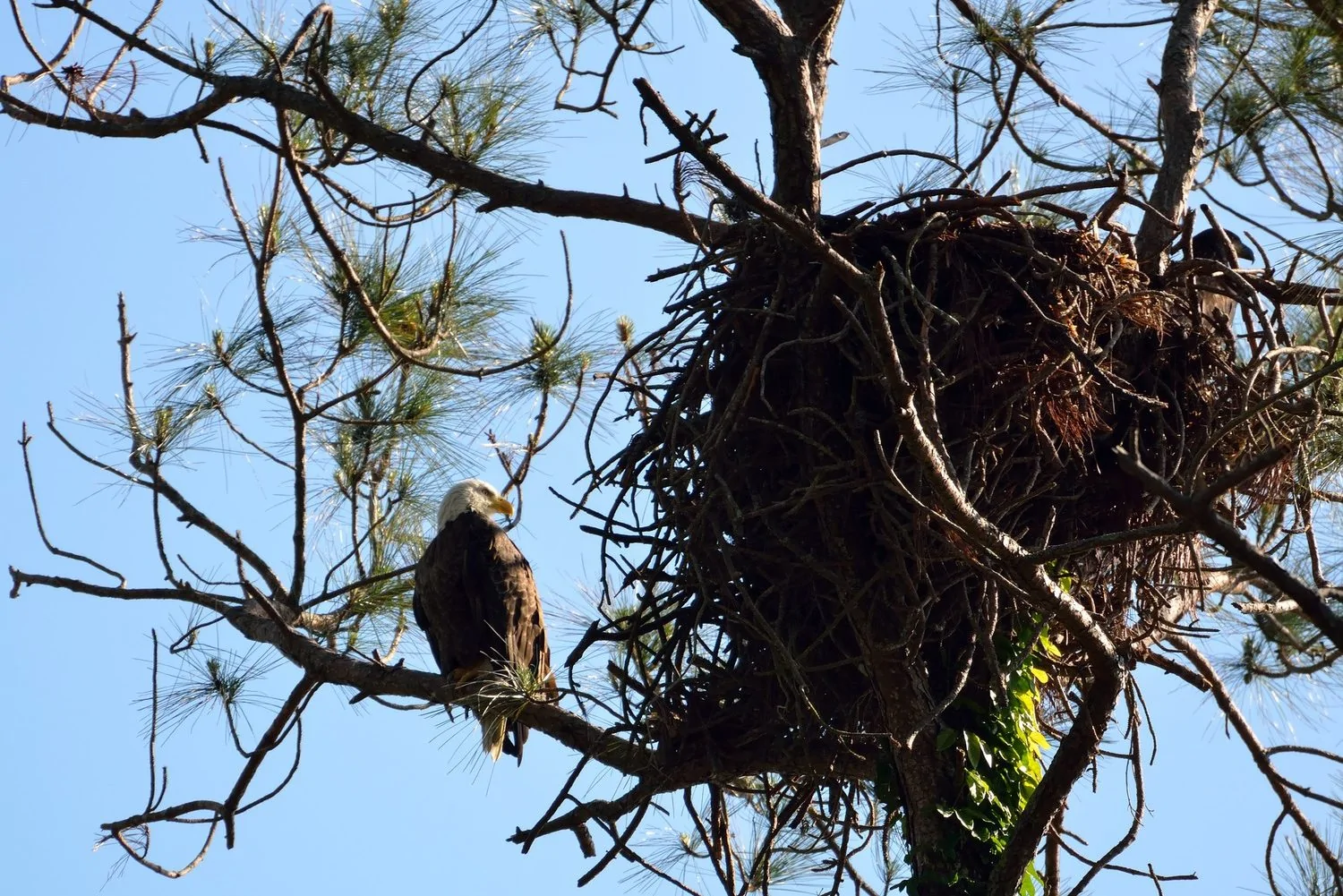
Females may lay one to three eggs per year in the wild. In captivity, they may lay up to seven eggs. The parents take turns in incubating the eggs for thirty-five days. Whoever is not sitting on the eggs gets to hunt for food to feed the other.
Fun Fact: The Bald Eagle has been the national symbol of America since 1782. It may be named “bald,” but it isn’t actually bald. The old version of “bald” actually meant “white,” referring to its white head and tail.
20. Boreal Chickadee
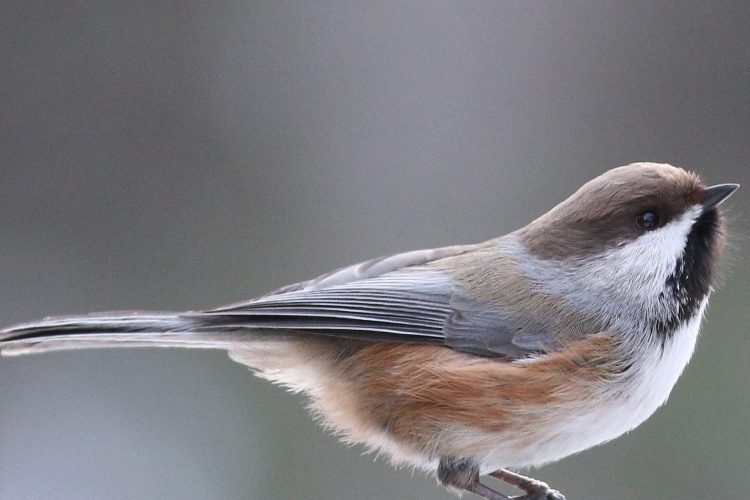
Boreal Chickadees are tiny grayish-brown songbirds with a dark brown cap, small black bib, cinnamon sides, and white underneath and on the cheeks.
- Poecile hudsonicus
- Length: 4.9-5.5 in (12.5-14 cm)
- Weight: 0.3-0.4 oz (7-12.4 g)
Boreal Chickadees live in Canada and Alaska and may appear in northern US states.
You can find Boreal Chickadees mostly in coniferous forests, often near water, but also can be found in deciduous or mixed forests. They feed on seeds and insects from the upper areas of the canopy and will readily visit feeders.
Attract Boreal Chickadees to your backyard with Black oil sunflower seeds, nyjer seeds, suet, peanuts, and mealworms on most types of feeders. Also, put up a nesting box to attract a mating pair.
Fun Fact: Boreal Chickadees will store seeds and insects for the long and harsh winter.
21. Dark-eyed Junco
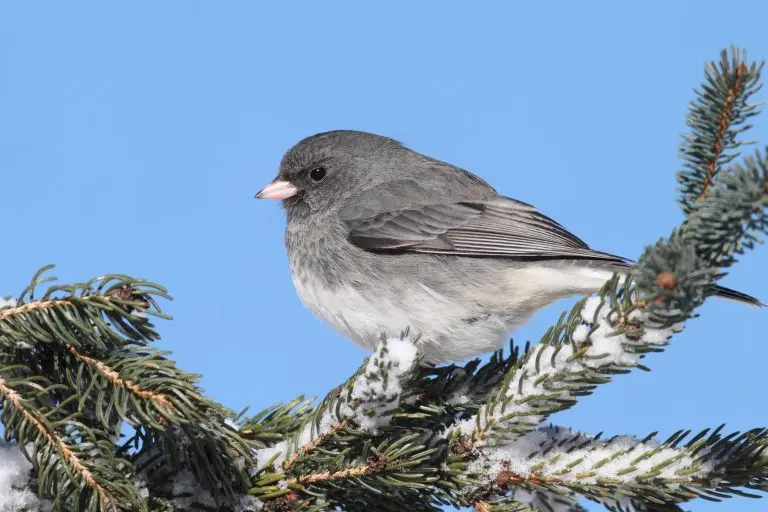
Dark-eyed Juncos are sparrows that are different colors depending on the state. They are generally slate-colored in the east and black, white, and brown in the west.
- Junco hyemalis
- Length: 5.5-6.3 in (14-16 cm)
- Weight: 0.6-1.1 oz (18-30 g)
- Wingspan: 7.1-9.8 in (18-25 cm)
Dark-eyed Juncos remain resident all year in northeastern and western US states and the Appalachian Mountains. Those that breed in Canada and Alaska migrate south in winter to the United States.
They can be found in open and partially wooded areas, often on the ground, and are common across the continent.
Dark-eyed Junco Song:
Attract Dark-eyed Juncos to backyard feeders with a variety of seeds such as black oil sunflower seeds, nyjer, cracked corn, millet, and peanuts. Platform feeders or scattered on the ground are best.
22. Common Merganser
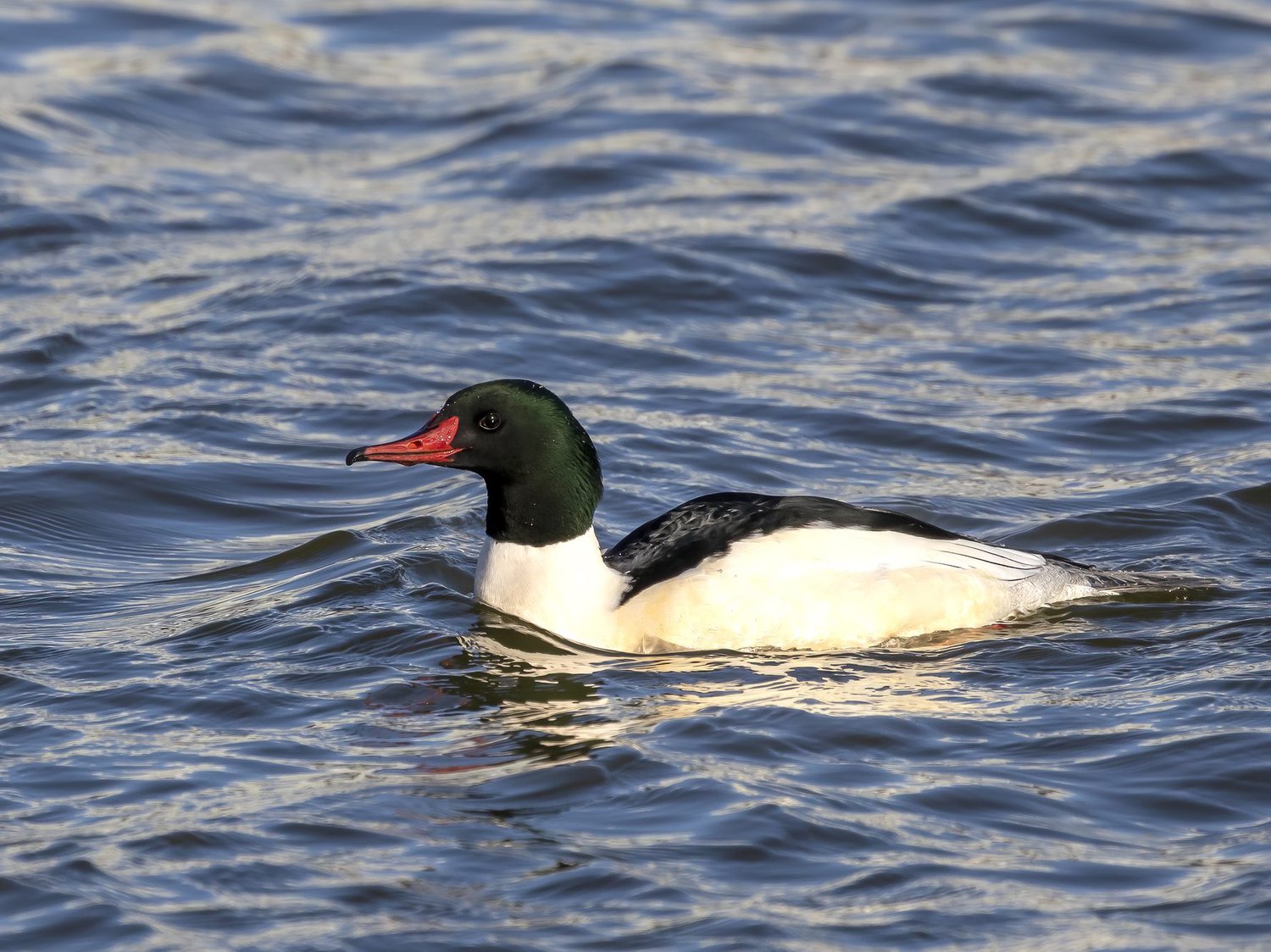
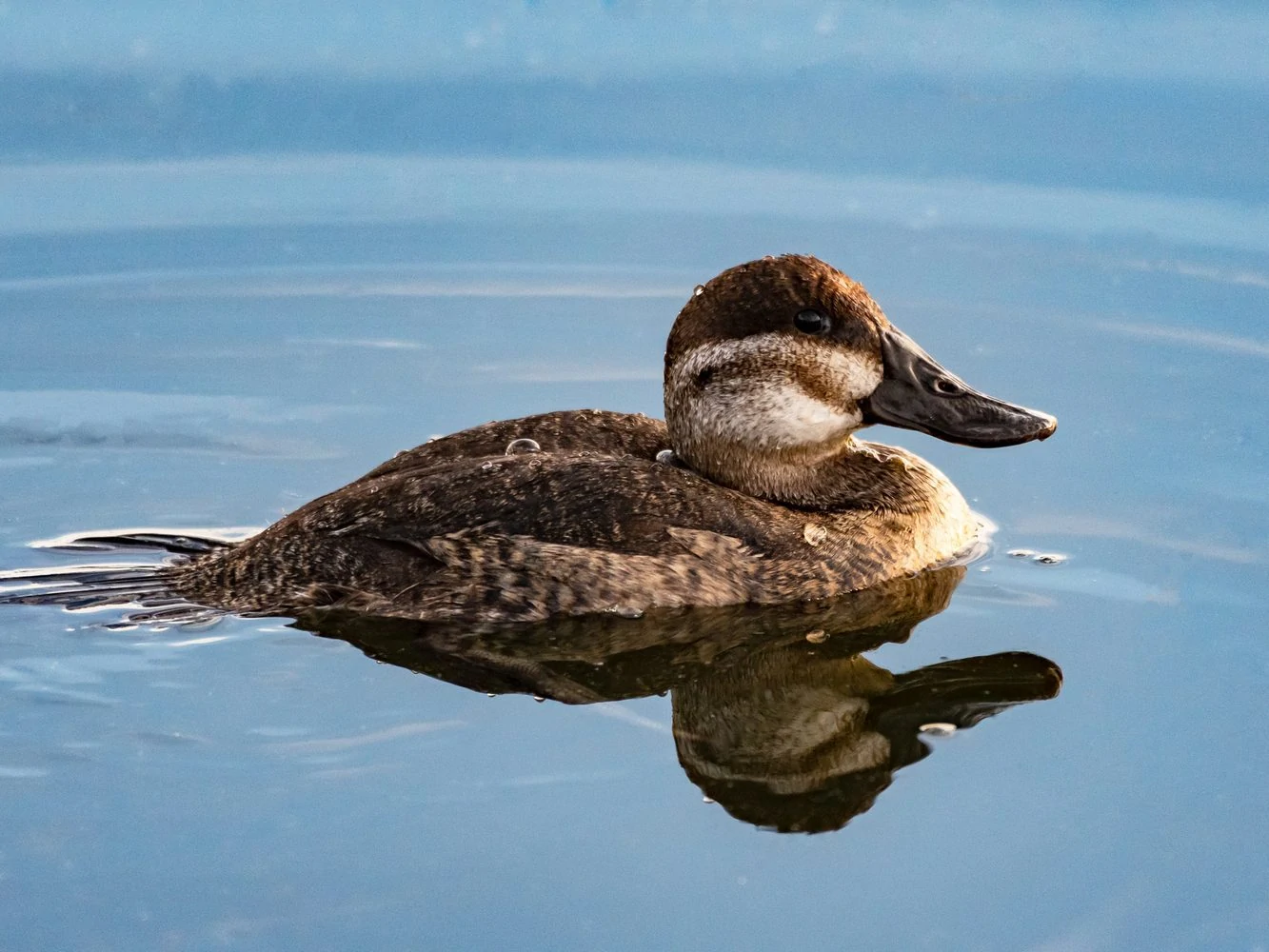
Male Common Mergansers are simple-patterned birds but striking nonetheless. They have black heads with a glossy green sheen, dark eyes, bright-red, long, serrated bills, white bodies, and black backs. While they do have a crest, it’s not often visible.
Females have a more prominent reddish-brown crest. They have the same red, serrated bill as the males. They also have a white chin patch, and their breast and bellies are white, their backs are gray. Juveniles resemble females.
- Mergus merganser
- Length: 22 – 27 in (56 – 69 cm)
- Weight: 60.8 oz (1723 g)
- Wingspan: 31 – 37 in (79 – 94 cm)
Common Mergansers breed in Canada and migrate to the US. Some remain all year in northeastern and northwestern US states.
You can find Common Mergansers in freshwater lakes and ponds. They are also found in small rivers and shallow shorelines and even sitting on rocks in the middle of a stream. While they prefer freshwater habitats, they sometimes visit saltwater regions too, like coastal estuaries and harbors.
Common Mergansers are diving ducks, and they love to eat fish, particularly the adults. Their serrated bills make it easy for them to capture and hold these fish as well as mussels, crustaceans, and other aquatic creatures. Gulls often follow them when hunting to steal the fish from them.
Common Merganser Calls: They are usually fairly quiet, but Male Common Mergansers give alarm calls, and females make a series of grunting calls to their young.
Male Common Merganser call
Female Common Merganser call
Fun Fact: Common Mergansers are also called “sawbills,” “fish ducks,” or “goosanders.”
23. Pileated Woodpecker
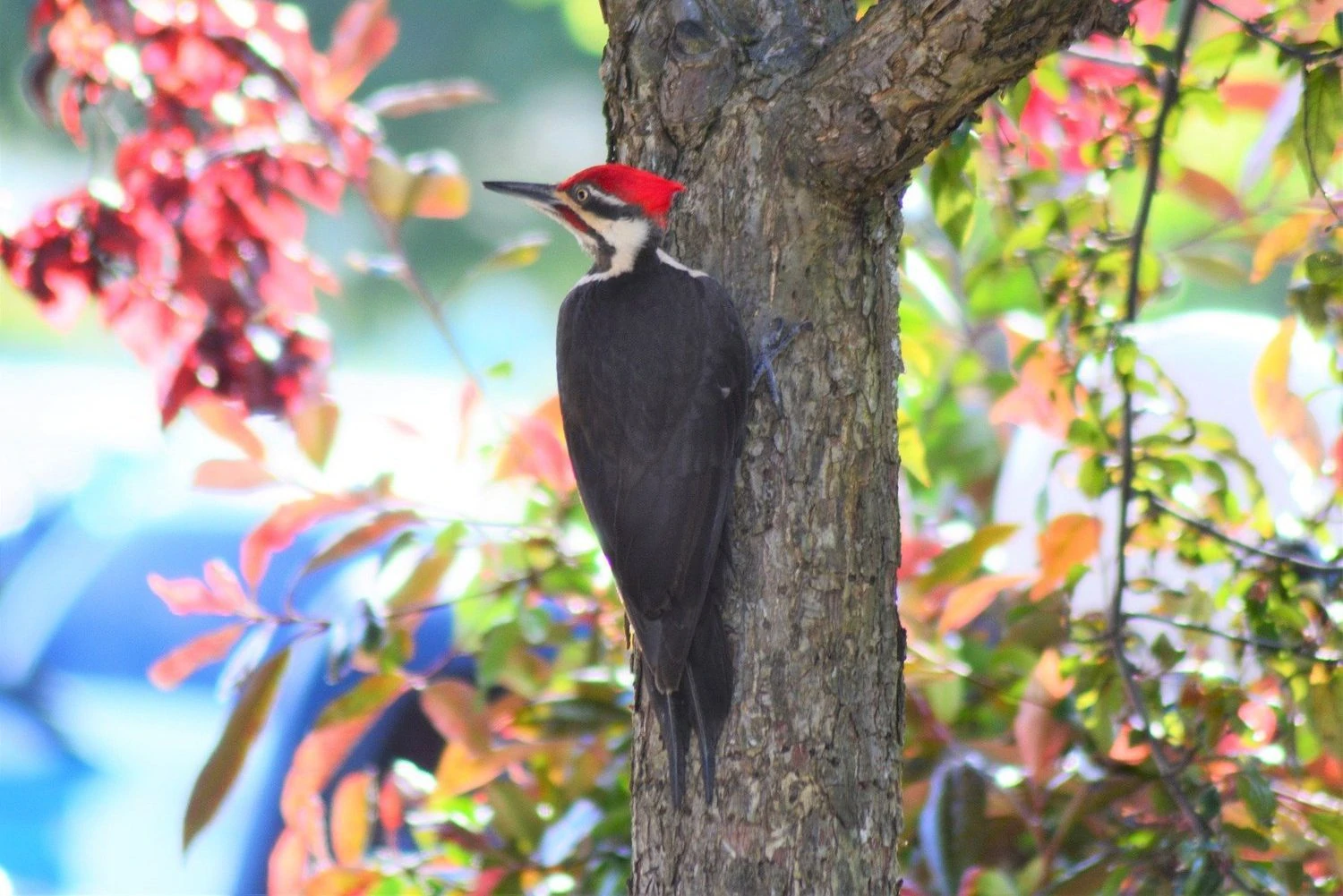
Pileated Woodpeckers are the biggest woodpecker in North America, and their flaming-red triangular crest is very striking.
They are black with a white stripe, and when flying, the white underside of the wings can be seen. Males have an additional red stripe on the cheek.
- Dryocopus pileatus
- Length: 15.8-19.3 in (40-49 cm)
- Weight: 8.8-12.3 oz (250-350 g)
- Wingspan: 26.0-29.5 in (66-75 cm)
They live all year in eastern US states, across Canada, and into northwestern US states.
Pileated Woodpeckers mostly eat carpenter ants from dead trees and fallen logs, but they also eat beetle larvae, termites, and other insects as well as fruit and nuts such as blackberries, sumac berries, dogwood, and elderberry. They make a loud shrill, whinnying call and deep, loud drumming.
Pileated Woodpecker Call:
Attract Pileated Woodpeckers to your backyard with suet feeders that have tail props.
24. Mountain Chickadee
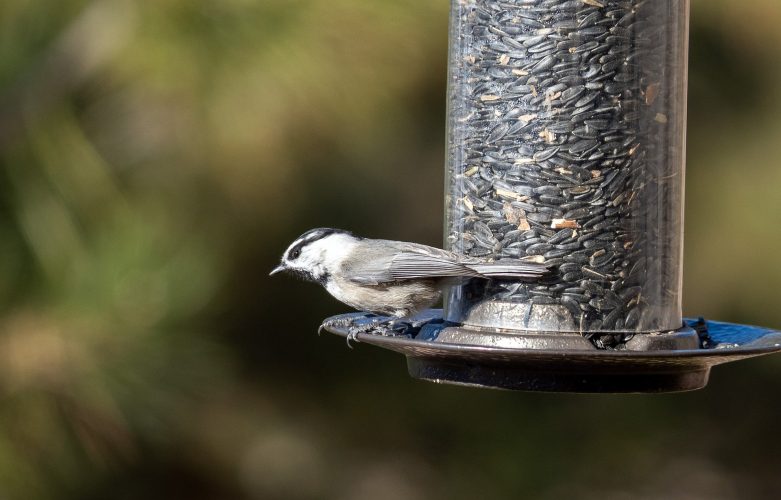
Mountain Chickadees are tiny birds with black-and-white heads and gray over the body, darker on the back and light gray underneath.
- Poecile gambeli
- Length: 4.3-5.5 in (11-14 cm)
- Weight: 0.4 oz (11 g)
Mountain Chickadees live in the mountains west of the US all year and do not migrate but may move down the mountain to lower areas in winter.
You can find Mountain Chickadees in evergreen forests, especially those with pine and conifers. They eat insects and spiders, nuts, and seeds and will often visit backyard feeders. Mountain Chickadees will often stash food for later and create a store of food.
Attract Mountain Chickadees to your yard by putting up nest boxes, and they will visit most types of feeders with black oil sunflower seeds, mealworms, nyjer, suet, and peanut butter.
Fun fact: The eggs of Mountain Chickadees are incubated 50% longer than other chickadee species, probably due to the protection that their old woodpecker nests give and the fact the female covers the eggs when she leaves.
25. Bufflehead
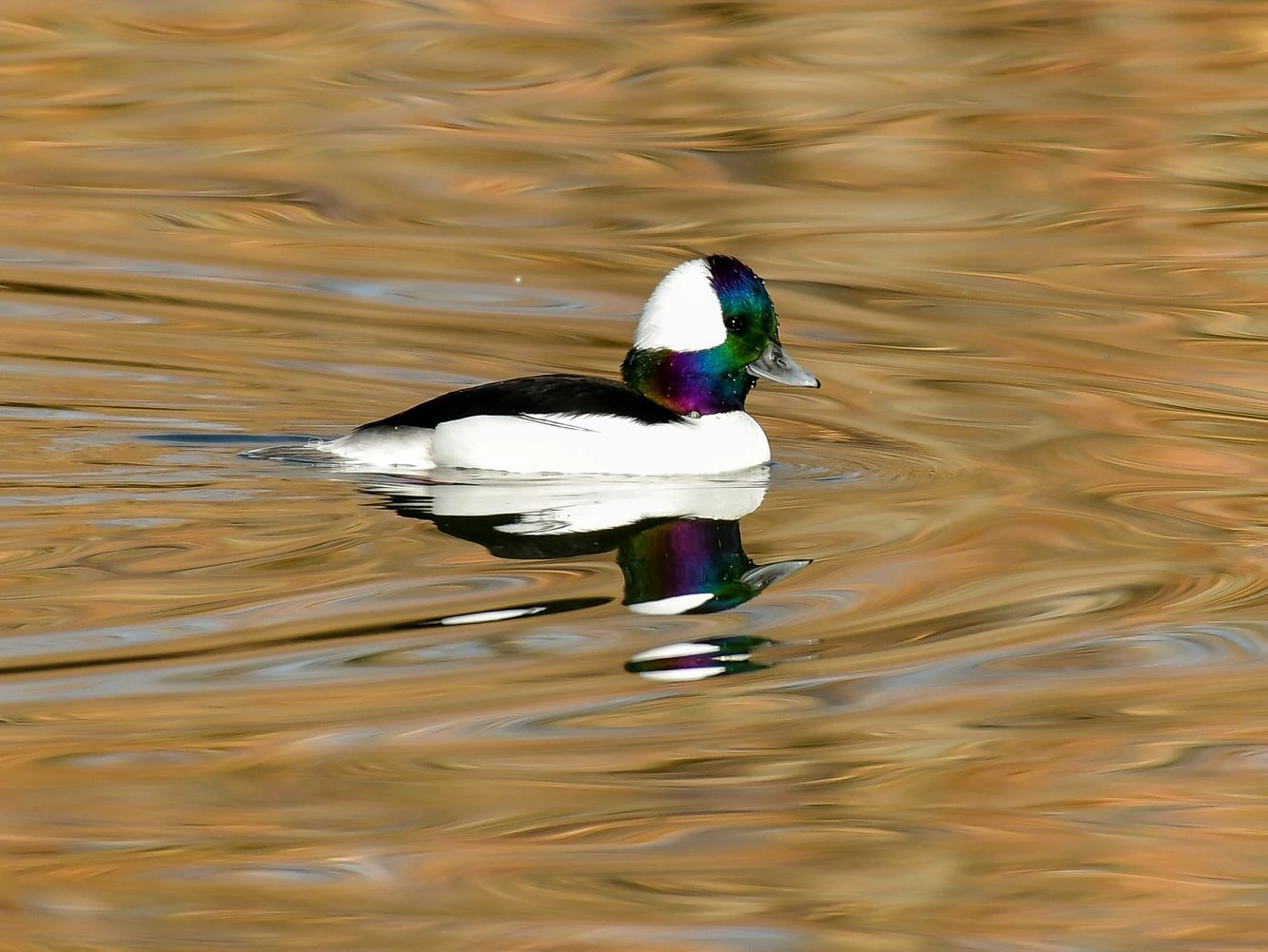
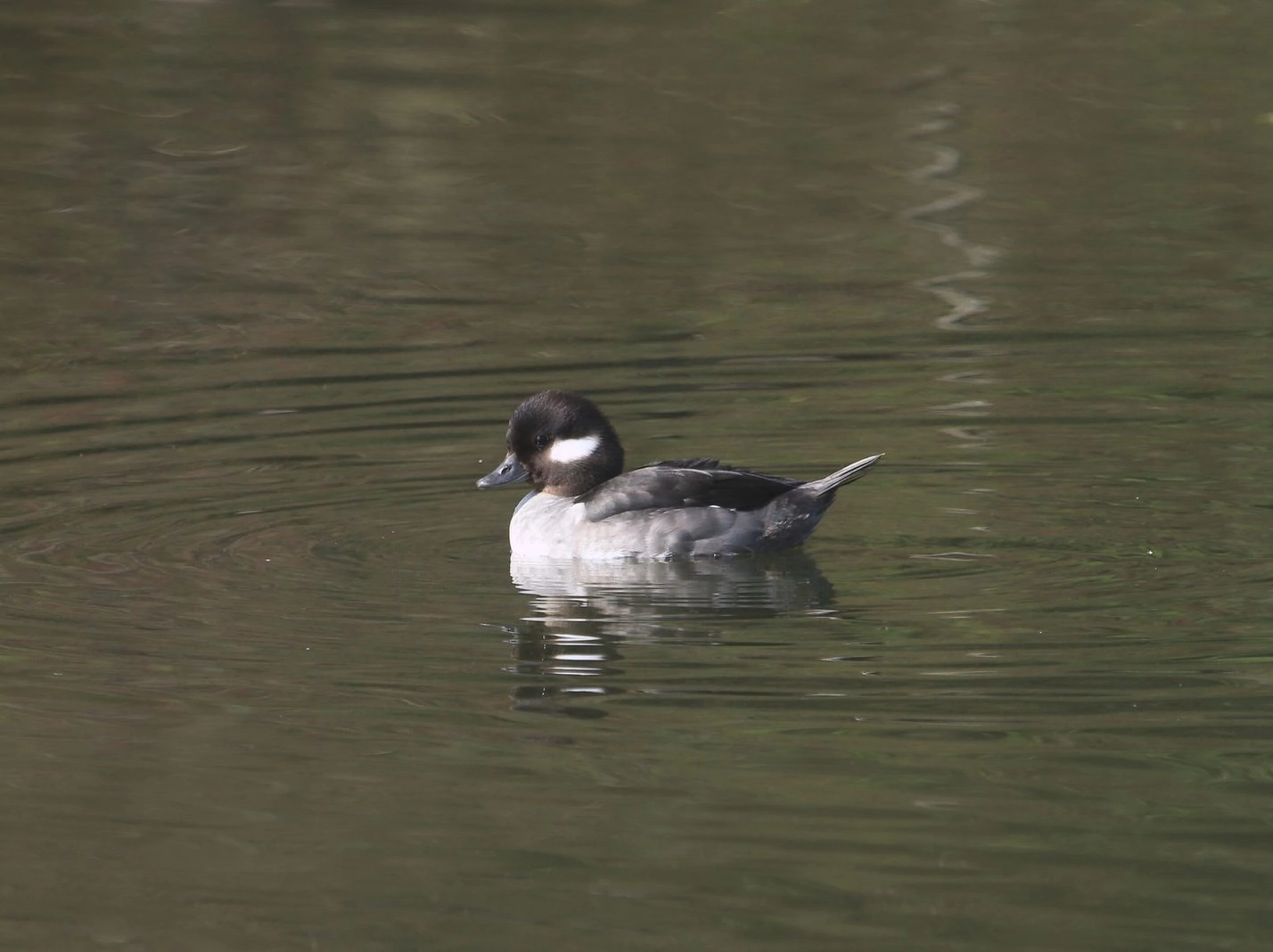
Buffleheads are small birds with bulbous heads, hence their name, “bullheaded,” from ancient Greek. Male Buffleheads are easily recognizable because of the huge white patch behind their eyes. This patch highlights the glossy green and purple colors on the crown, forehead, throat, and neck. The bottom half of their bodies are white, while the upper half is black.
Female Buffleheads look nothing like the males, except for the bulbous head. They have dark brown or black heads with a white patch below the eye. Their bottom half is gray, and their top half is black. Juveniles look similar to females with their brown heads and a white patch on the head.
- Bucephala albeola
- Length: 13 – 16 in (33 – 41 cm)
- Weight: 21.16 oz (600 g)
- Wingspan: 20 – 24 in (51-61 cm)
Buffleheads breed mainly in Canada before migrating to the US, northern Mexico, and Canada’s Pacific coast. They can be seen during migration in the Midwest and the Appellations.
You can find Buffleheads in small lakes and ponds with nearby poplar and aspen forests during the breeding season. In the winter, they move to protected coastal waters or shallow bays and inlets.
Buffleheads mostly dive as they forage for food. They catch mollusks, crustaceans, and aquatic insects, which they eat while underwater.
Bufflehead Calls: Buffleheads are quiet birds and don’t make particularly loud calls. Males usually only make sounds around the breeding season and make chattering sounds or squeals. Females call to their young.
Male Bufflehead call
Female Bufflehead call
Attract Buffleheads to your backyard by putting up nest boxes. There is a lot of nest competition with other goldeneyes, which drives Buffleheads to seek safer and better nesting areas.
Fun Fact: Buffleheads are monogamous ducks and may remain with their chosen mate for several years.
Winter vs Summer Birds Alberta
There are some birds that stay all year in Alberta but many migrate in or out in the spring and fall. These lists give you the most common birds recorded in checklists by bird watchers in summer or winter on ebird.
Winter Birds Alberta:
Black-billed Magpie 66.66%
Black-capped Chickadee 63.32%
Common Raven 43.54%
Downy Woodpecker 37.57%
House Sparrow 34.50%
Blue Jay 27.57%
Red-breasted Nuthatch 25.34%
White-breasted Nuthatch 22.99%
Common Redpoll 22.39%
Northern Flicker 22.33%
House Finch 18.22%
Canada Goose 16.95%
Hairy Woodpecker 16.65%
Mallard 15.87%
Rock Pigeon 15.64%
Summer Birds Alberta:
American Robin 49.83%
American Crow 39.49%
Black-capped Chickadee 37.28%
Black-billed Magpie 35.31%
Red-winged Blackbird 33.67%
Mallard 32.67%
Yellow Warbler 30.52%
Cedar Waxwing 30.47%
Clay-colored Sparrow 25.54%
Common Raven 23.94%
House Wren 23.85%
Tree Swallow 22.56%
House Sparrow 22.43%
American Goldfinch 22.01%
Canada Goose 21.47%

